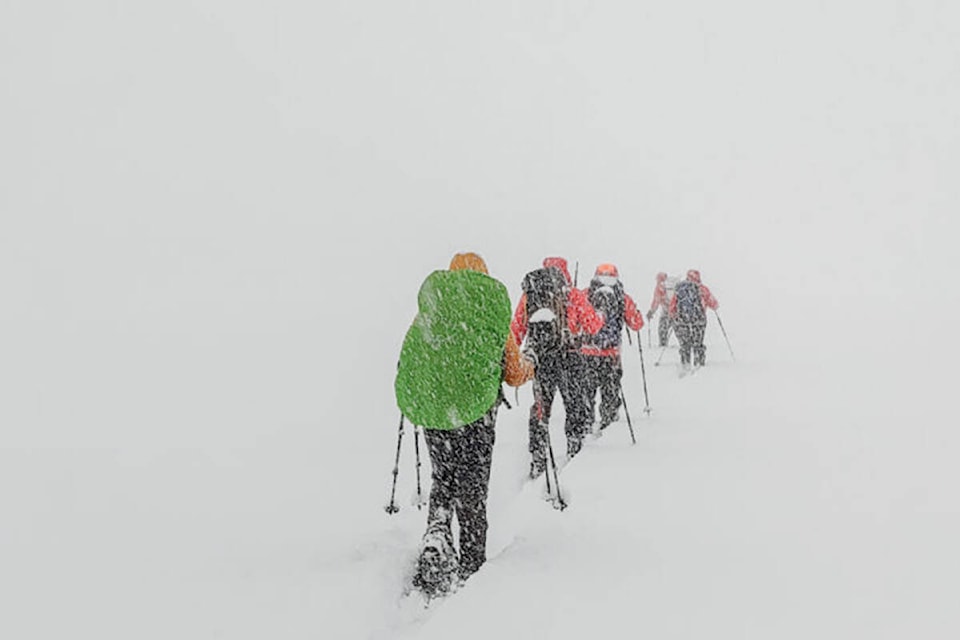Evan Paterson is hardly a newbie when it comes to adventuring in B.C.’s wild places.
However, like many before have learned, sometimes it is exceedingly difficult to prepare for the adversity Mother Nature can whip up on a whim.
Paterson and his brother-in-law ended up needing the help of Comox Valley Search and Rescue after an idyllic winter camping trip in Strathcona Provincial Park earlier this month turned scary.
Paterson, who lives in Nanaimo, wrote about the incident on his blogging site lostandlooking.com , and the post has been making the rounds on many Vancouver Island hiking group forums.
“The weather really caught us off guard,” Paterson said in an interview with The Mirror. “We expected snow, but not over three feet of snow.
In preparation for the journey to the Forbidden Plateau region, the two adventurers had set out on several day-hikes to test their equipment, and “get a feel for the expected winter conditions.”
The plan was to start the new year with an exciting challenge, and a challenge it was.
They set off from the Raven Lodge Parking lot on Jan 1, headed south past Battleship Lake, and made their way to Lake Helen Mackenzie campground.
From there they maneuvered across the frozen Lake Helen Mackenzie. Paterson said the plan was to to reach Mt. Drabble, but they realized it was a little ambitious, so they scrapped that. Instead, they camped at Kwai Lake, which was a planned checkpoint on their itinerary about eight kilometres away from the trailhead.
READ MORE: Search and rescue is free so don’t delay, association reminds British Columbians
READ MORE: Campbell River SAR perform overnight rescue on Vancouver Island’s tallest mountain
After a hard day’s work, Paterson said they turned in by sunset, but a well-deserved sleep was interrupted when he heard his brother-in-law calling out to him from his tent.
Paterson said he noticed the sides of his own tent had been caved-in, and when he took a peak outside, he said their shelters had been completely buried by snowfall.
It took an hour to dig out.
“At that point we weren’t too concerned as we were still warm,” Paterson said. “But it was definitely the first indicator that we were going to get more snow than we expected.”
In morning they dug themselves out again, before enjoying a quick breakfast, and hitting the trail home.
Quickly, the pair realized they were in trouble.
“It was really just the suffocating amount of snow,” he said. “It was holding on to us, and we were practically swimming for a couple hundred metres.”
Paterson and his brother-in-law would take turns taking the lead. The first person was packing down the snow enough for the person trailing to avoid sinking into it.
“The snow was still going up to our waist even with the snowshoes,” he said.
After three hours of slogging, they had to assess options. Paterson said they were choosing between going back to Kwai Lake or making a push for a ranger cabin they had passed on their way in. It was also this point they decided to send out a distress signal via Paterson’s SPOT device.
“We knew it was time to call for help,” he said. “Based on the rate we were moving all morning, there was no way we were getting out on time.”
They opted to push on for the ranger cabin. As luck would have it, a search and rescue team turned up shortly after they reached it.
“It was pretty convenient as they were were out looking for a couple skiers and their dog,” Paterson said. “They said that if that wasn’t the case, they probably wouldn’t have been able to make it out that day.”
Paul Berry is the president of Comox Valley Search and Rescue, and was search manager on the task. He praised the snowshoers for making the call when they did.
“They had a good appreciation of the difficulty they were in,” he said. “They realized it was going to be late in the day or middle of the night before they were able to get out just because of the heavy snow, and the difficulties of pushing through it on their snowshoes.”
There was close to 100 centimetres of back country snow on Jan. 2, Berry clarified.
“Snowshoes are like sea anchors in those conditions,” he said. “Breaking trail that entire time with the snowshoes buried under the snow, is incredibly hard going.”
It was even difficult for the search and rescue team which was equipped with back country skis.
Berry advised back country enthusiasts to check the correct weather data before embarking on any trips.
“They had looked at weather for the Courtenay area, and not the weather systems that were going to impact the mountains,” he said of the snowshoers. “So they were anticipating 20 cm of snow, and not 100.
“If they assessed and looked at the correct weather bulletin, I would have hoped they would have made the decision not to go where they went that day.”
ronan.odoherty@campbellrivermirror.com
Like us on Facebook and follow us on Twitter
